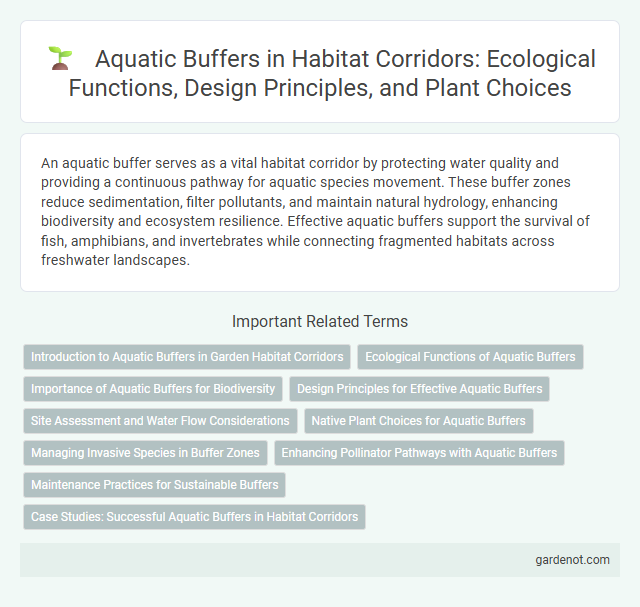An aquatic buffer serves as a vital habitat corridor by protecting water quality and providing a continuous pathway for aquatic species movement. These buffer zones reduce sedimentation, filter pollutants, and maintain natural hydrology, enhancing biodiversity and ecosystem resilience. Effective aquatic buffers support the survival of fish, amphibians, and invertebrates while connecting fragmented habitats across freshwater landscapes.
Introduction to Aquatic Buffers in Garden Habitat Corridors
Aquatic buffers in garden habitat corridors serve as critical zones that protect water quality by filtering runoff and reducing sedimentation in adjacent aquatic ecosystems. These buffers, composed of native vegetation such as grasses, shrubs, and trees, provide essential habitat for amphibians, insects, and other wildlife while enhancing biodiversity. Effective design of aquatic buffers incorporates appropriate plant selection and buffer width to maximize pollutant absorption and support ecological connectivity.
Ecological Functions of Aquatic Buffers
Aquatic buffers serve essential ecological functions by filtering pollutants, stabilizing stream banks, and maintaining water quality in habitat corridors. These buffers enhance biodiversity by providing habitat connectivity and supporting aquatic and terrestrial species movement. Their role in nutrient cycling and sediment retention also protects downstream ecosystems from degradation.
Importance of Aquatic Buffers for Biodiversity
Aquatic buffers play a crucial role in maintaining biodiversity by filtering pollutants and reducing sedimentation in water bodies, thereby preserving aquatic habitats. These vegetated zones along waterways provide essential refuge and breeding grounds for diverse species, enhancing ecosystem resilience. Protecting and restoring aquatic buffers supports water quality and habitat connectivity critical for sustaining native flora and fauna populations.
Design Principles for Effective Aquatic Buffers
Aquatic buffer design principles emphasize maintaining native vegetation to stabilize banks, filter pollutants, and provide habitat connectivity for aquatic species. Effective buffers require adequate width--typically 30 to 100 feet--tailored to slope, soil type, and land use to maximize nutrient retention and sediment control. Integrating diverse plant species enhances resilience against erosion and supports biodiversity within habitat corridors.
Site Assessment and Water Flow Considerations
Aquatic buffer zones are critical in habitat corridor site assessments, as they help maintain water quality and stabilize stream banks by filtering pollutants and reducing sediment runoff. Understanding local hydrology and water flow patterns ensures that buffer placement supports natural water movement, prevents erosion, and sustains aquatic habitats. Effective water flow considerations involve analyzing watershed dynamics, floodplain connectivity, and seasonal variations to optimize habitat connectivity and biodiversity within the corridor.
Native Plant Choices for Aquatic Buffers
Native plant choices for aquatic buffers include species such as willows (Salix spp.), sedges (Carex spp.), and wild rice (Zizania spp.), which enhance water quality by filtering pollutants and stabilizing soil. These plants provide critical habitat for aquatic and terrestrial species, support biodiversity, and improve the overall resilience of habitat corridors. Selecting regionally adapted native plants ensures better establishment, growth, and ecological function within aquatic buffer zones.
Managing Invasive Species in Buffer Zones
Aquatic buffers play a critical role in managing invasive species by creating physical and ecological barriers that limit their spread in habitat corridors. Effective management involves maintaining native vegetation and monitoring water quality to support native aquatic species while suppressing invasives. Implementing strategies such as controlled removal and restoration planting enhances biodiversity and preserves the integrity of aquatic ecosystems within buffer zones.
Enhancing Pollinator Pathways with Aquatic Buffers
Aquatic buffers play a crucial role in enhancing pollinator pathways by providing diverse, moisture-rich habitats that support the lifecycle of pollinating insects such as bees, butterflies, and hoverflies. These vegetated riparian zones reduce pesticide runoff, improve water quality, and create continuous corridors linking fragmented ecosystems, which facilitates pollinator movement and genetic exchange. By integrating native plants with high nectar and pollen availability, aquatic buffers strengthen habitat connectivity, increasing resilience for pollinator populations in both terrestrial and aquatic environments.
Maintenance Practices for Sustainable Buffers
Effective maintenance practices for aquatic buffers involve regular removal of invasive species and controlling sediment runoff to preserve water quality and habitat connectivity. Utilizing native vegetation in buffer zones enhances root stability, reducing erosion and improving filtration of pollutants before they reach aquatic ecosystems. Periodic monitoring and adaptive management ensure the buffer's resilience, promoting long-term sustainability of aquatic corridors.
Case Studies: Successful Aquatic Buffers in Habitat Corridors
Case studies demonstrate that well-designed aquatic buffers in habitat corridors significantly improve water quality by filtering pollutants and stabilizing stream banks, enhancing biodiversity. For example, the Chesapeake Bay watershed project restored riparian buffers, resulting in increased native fish populations and reduced sediment runoff. These successful implementations highlight the critical role of aquatic buffers in maintaining habitat connectivity and ecosystem resilience.
Aquatic buffer Infographic

 gardenot.com
gardenot.com